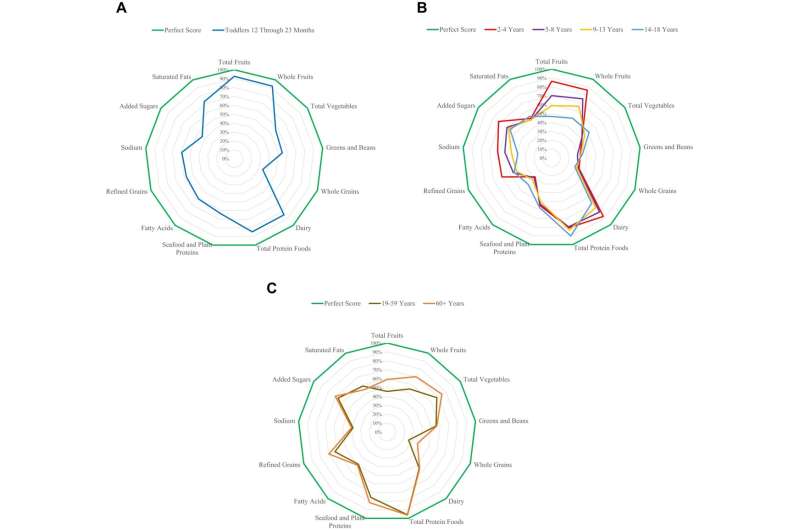This article has been reviewed according to Science X's editorial process and policies. Editors have highlighted the following attributes while ensuring the content's credibility:
fact-checked
peer-reviewed publication
trusted source
proofread
Latest version of the Healthy Eating Index covers toddler diet quality

In four new articles in the Journal of Nutrition and Dietetics, leading nutrition experts describe and evaluate the latest versions of the Healthy Eating Index (HEI), issued to correspond to the 2020–2025 Dietary Guidelines for Americans (DGA). For the first time, there are two new HEIs, one for children and adults 2 years and older, and one for young children aged 12 through 23 months.
The Call to Action of the ninth edition of the Dietary Guidelines for Americans is "Make Every Bite Count." These guidelines form the basis of nutrition policy for the US Government and the foundation of all federal nutrition guidance. Developed to measure alignment with the evidence-based DGA, the HEI is a tool designed to measure diet quality—that is, how closely an eating pattern or mix of foods matches the recommendations in the DGA.
Four articles were written by the Healthy Eating Index Team, through a collaboration between the HHS, National Cancer Institute, and the USDA Food and Nutrition Service.
Jill Reedy, Ph.D., MPH, RDN, Chief, Risk Factor Assessment Branch, National Cancer Institute, explained, "For the first time, the current DGA (2020–2025) includes a USDA Dietary Pattern for toddlers aged 12 through 23 months. The HEI has a long and robust history of evolving to align with the state of the science. The development of the HEI-Toddlers-2020 is a clear example of this and answers the call by the 2020 Dietary Guidelines Advisory Committee to 'develop a dietary pattern scoring system, such as the Healthy Eating Index (HEI), for infants and children from birth to 24 months, considering findings from this report and future dietary guidance.'"
Reflecting the current DGA, the HEI articles cover the two separate indices: the HEI-2020 and the new HEI-Toddlers-2020. In addition to an introductory editorial, they include one article that highlights the HEI-2020 that was updated for children and adults (i.e., two years and older); two articles on the new HEI-Toddlers-2020 that was developed and evaluated for toddlers 12 through 23 months; and an overarching article that discusses the continuity, considerations, and future directions for diet quality throughout the lifespan. They contribute to the growing literature on dietary patterns, toddler nutrition, and the healthy eating trajectory.
Both the HEI-Toddlers-2020 and the HEI-2020 have 13 components, each of which reflects an important aspect of diet quality. Nine components focus on adequacy (foods we should eat enough of to get the nutrients we need and for overall good health), and four components focus on moderation (dietary components that should be limited or consumed in small amounts). Calculations using the HEI-Toddlers-2020, like the HEI-2020, result in a total score and a set of individual component scores that reveal a dietary pattern.
HEI-Toddlers-2020 and HEI-2020 radar plots including total scores for each age group are shown. Total HEI scores across the lifespan are suboptimal with the highest scores being for young children ages 12 through 23 months (HEI-Toddlers-2020 Total Score 63.4) and adults 60 years and older (HEI-2020 Total Score 59.5).
The HEI-Toddlers-2020, like HEI-2020, has 13 components reflecting all constituents of dietary intake, except for human milk or infant formula. Healthy dietary patterns for toddlers have unique considerations reflected in the scoring standards for Added Sugars and Saturated Fats, notably:
- A recommendation to avoid added sugars (the guidance for ages 2 and older recommends limiting added sugars to less than 10% of calories per day)
- No recommendation to limit saturated fats to less than 10% of energy intake (the guidance for ages 2 and older recommends limiting saturated fats to less than 10% of energy intake)
Kirsten A. Herrick, Ph.D., MSc, Program Director, National Cancer Institute, and lead author of a contribution on the future directions of the HEI, commented, "The scientific evidence base may continue to evolve and lead to further refinement for tailored recommendations within the birth to 24 months age group, across the lifespan, and to other potential age groupings based on developmental milestones and other concepts about health over time."
TusaRebecca Pannucci, Ph.D., MPH, RDN, Branch Chief, USDA Food and Nutrition Service, lead author of a contribution on the development of the HEI-Toddlers-2020 stated, "The 2020-2025 edition of the DGA was the first to include comprehensive recommendations for dietary patterns in the second year of life and was the key driver in informing the creation of the HEI-Toddlers-2020. We recognize, as the DGA emphasize, 'every bite counts,' and every shift toward a healthy dietary pattern should be acknowledged."
Marissa M. Shams-White, Ph.D., MSTOM, MS, MPH, Program Director, National Cancer Institute, lead author of a contribution on the review and update process for HEI 2020-2025, added, "The HEI is used widely in different types of research, particularly as the concept of dietary patterns has grown and continues to evolve. There is continued encouragement for research efforts to add to the scientific evidence base on dietary patterns and help address further methodological questions, including examining needs specific to each life stage and considerations for bridging across them."
The DGA was first published in 1980 and is updated every five years, leading to changes in emphasis and quantification. The DGA provides advice to consumers on what to eat and drink to meet nutrient needs, promote health, and prevent disease. The Dietary Guidelines Advisory Committee drafts a report about the guidelines for a professional audience, including policymakers, health care providers, nutrition educators, and federal nutrition program operators. A new HEI is issued to correspond to each new edition of the guidelines and to reflect these changes.
More information: Jill Reedy, The Evolving Healthy Eating Index: Advancing Metrics to Capture Dietary Patterns Across a Healthy Eating Trajectory, Journal of the Academy of Nutrition and Dietetics (2023). DOI: 10.1016/j.jand.2023.05.010

















